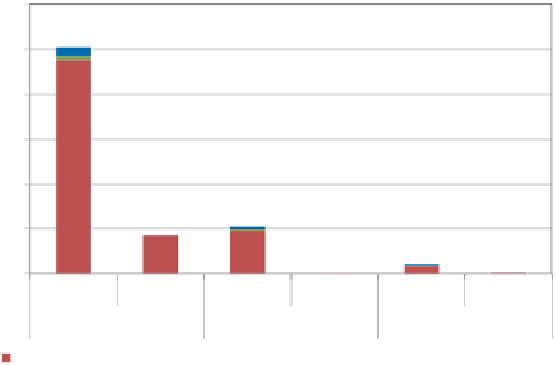Environmental Engineering Reference
In-Depth Information
͕͖
ϬϬ͘Ϭϴ
͕͔
͜
͚
͘
Ϯ͘ϬϬ
Ϭ͘ϳϬ
͖
Ϭ͘ΚϬ
Ϭ͘ϬϮ
Ϭ͘ϬΡ
͔
Fig. 9.2
The amount of input and embodied phosphorus demand associated with food demand
(Unit: kg-P)
9.3.4.2
Selecting Stakeholders Based on the IPCIO Model
Japan has no phosphate ore deposits and therefore relies on imports for nearly all
phosphorus resources. Of the phosphorus resources imported into Japan, 77 %
(251.1 kt-P) is used for the manufacture of fertilizers, while the rest is used for the
manufacture of industrial chemical products such as phosphorus compounds. The
most significant stakeholder in relation to the consumption of phosphorus resources
is therefore the agriculture sector, and the production process of rice plays a major
part in this consumption. The agricultural sector is not only the largest consumer,
but it also holds a prominent position in the accumulation and dispersion of phos-
phorus on agricultural land (Fig.
9.3
). Phosphorus compounds manufactured by the
chemical industry sector predominantly comprise dry phosphoric acid and yellow
phosphorus derivatives, of which almost 20 % is used in applications for metal sur-
face treatment. In spite of the fact that much of the phosphorus used is transferred
into sewage sludge, currently the majority of phosphorus is not being recycled.
Agriculture and metal surface treatment industries are therefore considered signifi-
cant stakeholders from the perspective of both use and dispersion. Phosphorus that
flows into the iron and steel industry to accompany iron ore, coke and others, is only
present in minute quantities, but is almost entirely transferred to steelmaking slag.
It is not recycled as a phosphorus resource, and thus, the iron and steel industry is
also a significant stakeholder from the perspective of dispersion.
Furthermore, when the demand for yellow phosphorus in the supply chain was
estimated, it was revealed that soap and synthetic detergent manufacturing as well
as dyeing were processes with a high 'per economic activity unit' demand for yel-
low phosphorus (Fig.
9.4
). Focusing on final products, the copying machine and
automotive industries were identified as industries with the largest per unit demand,


